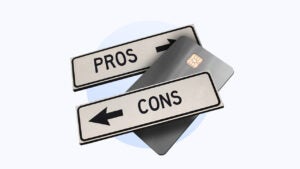I’m a credit cards editor. Here’s why I’m (mostly) bullish on Robinhood’s first credit card.

Citi is an advertising partner.
Robinhood announced a new cash back credit card this week, and I for one am very intrigued.
I’ve always been a big fan of cash back cards. I love the simplicity of both earning and redeeming cash rewards, especially since I never have to worry about calculating point values or weighing redemption options to be sure I’m getting the best deal.
Flat-rate cash back cards are the foundation of any good cash back card strategy, so when a new flat-rate card hits the scene, I take notice — even more so when the card’s rewards rate beats the 2 percent back typical of even the best flat-rate cash back cards.
Enter the Robinhood Gold Card*, the online brokerage’s first foray into credit cards. Like the Apple Card* before it, the Robinhood Gold Card may stand out for its sleek, numberless design, tech-forward approach and gold metal form factor. But unlike that card, the Robinhood Gold Card also impresses when it comes to earning rewards.
I signed up for the card’s waitlist soon after it was announced. My first impression is the Robinhood Gold Card can more than pull its weight, but there are a few red (or maybe beige?) flags that make me think twice.
Why I might get the card
While the Robinhood Gold Card may be best suited to existing Robinhood Gold users and fans of luxurious-looking metal cards, I think it could be a solid addition to any cash back lover’s wallet. This is thanks mostly to its terrific base rewards rate and its potential to slim down the typical cash back card stack.
It offers the best flat cash back rate out there (for now, at least)
The Robinhood Gold Card’s biggest selling point is definitely its base cash back rate: Unlimited 3 percent back in all categories. You’ll also earn 5 percent back on travel booked through the Robinhood travel portal, but since we still don’t have many details on that side of things yet, this factor doesn’t yet tip the scales for me.
A 3 percent cash back rate is easily the best flat rate I’ve seen on a (technically) no-annual-fee card, with even the best flat-rate cash back cards mostly topping off at 2 percent back. It caught the attention of Bankrate’s Senior Industry Analyst Ted Rossman for the same reason: “Right now, at least, the Robinhood card’s 3 percent cash back rate tops the market.” Indeed, the rate is so good that some industry experts have questioned how Robinhood will make it worth their while.
But unless and until that rate changes, the card should help you earn cash back on general purchases faster than any of its competitors.
The main catch is the card’s indirect cost: You must be a Robinhood Gold member to get the card, which means paying $50 per year or $5 per month in membership fees. I tend to avoid membership and annual fees unless I’m sure I’ll squeeze a ton of value out of an offer, so I did the math on how much I’d need to spend with the card to make it a better option than the 2-percent-flat-rate cards I already have.
Taking the $50 membership fee into account, it’ll take $5,000 in annual spending on general purchases for the Robinhood Gold Card to earn more overall than a no-annual-fee card that earns a flat 2 percent back. In other words, as long as I’m spending around $416 per month with the card, it will be a better deal — even with the membership fee.
That may sound like a lot, but remember: I won’t just earn 3 percent back in one or two categories, but on all purchases, including everyday expenses like groceries, dining, gas and online shopping. It’s all too easy to reach $416 in monthly spending on those alone.
The cost is easy to offset
Even if I couldn’t meet the $5,000 annual spending threshold that makes the Robinhood Gold Card a more lucrative option than 2-percent-flat-rate cards, I’m not sure the $50 annual membership fee would be a dealbreaker for me.
I’d only need to spend a little over $1,600 per year (or around $150 per month) to earn $50 cash back and break even by offsetting the annual cost of Robinhood Gold membership. That’s practically guaranteed even if I only use the card for a few regular bills like car insurance, internet and electricity.
In that sense, I don’t feel there’s much risk in adding the Robinhood Gold Card to my wallet. Worst-case scenario, I just offset the cost of Robinhood Gold and move on from the card after the first year.
That said, there are also other perks that come with Robinhood Gold membership that could help offset and justify the cost.
In particular, Robinhood currently offers a very generous 5 percent Annual Percentage Yield (APY) for Robinhood Gold members on uninvested brokerage cash that is swept to the banks in its program. Based on Bankrate’s savings calculator, I’d only need to deposit $1,000 to my Robinhood account as part of its cash sweep program to earn $50 in my first year as a Robinhood Gold member getting 5 percent APY.
I don’t have a Robinhood IRA, but Gold subscribers also get a 3 percent IRA match on eligible contributions, which is certainly worth a $50 fee given all the other benefits.
It could seriously streamline my card stack
Even if you stick to cash back over points and miles, maximizing your earnings still takes some effort. While you won’t have to worry about redemption values or transferring points, one card isn’t usually enough to get you a top rate in all your major spending categories.
If you opt for a single flat-rate cash back card that earns 1.5 or 2 percent back, you’ll likely be missing out on at least 1 percent back in several everyday categories — and if you opt for a tiered bonus category card, you’ll likely have to settle for a 1 percent cash back rate on general purchases.
Plus, it’s unlikely any one card will cover all your larger spending categories. In my experience, credit card rewards follow the rule of “You can only pick two,” but instead of “Good,” “Cheap” and “Fast,” you have “Groceries,” “Restaurants” and “Gas.”
As such, even a basic cash back card stack typically requires at least two — more likely three — cards: One flat-rate rewards card to cover general purchases, and one or two cards to cover key everyday spending categories like groceries, dining and gas. But this can easily grow to four, five or even more cards, depending on how dedicated you are to maximizing your cash back.
For reference, here’s my current go-to stack for everyday cash back:
- Citi Double Cash® Card: My card for all purchases not covered by other card bonus categories. It earns up to 2 percent back on all purchases (1 percent when you buy, then 1 percent when you pay off purchases)
- Citi Custom Cash® Card: My card for groceries, and only groceries. It earns 5 percent back in your top eligible spending category (on up to $500 in spending per billing cycle), and groceries are just one of the card’s options.
- Capital One SavorOne Rewards Credit Card: My card for dining and entertainment. It earns 3 percent back in these categories and includes nice perks like a complimentary Uber One membership (fee covered through Nov. 14, 2024).
- Blue Cash Everyday Card from American Express: My card for gas and online shopping. It earns 3 percent back at U.S. gas stations and with select online retailers.
- Bank of America® Customized Cash Rewards credit card: My card for wholesale clubs and other eligible bonus categories like home improvement and drugstores. It earns 3 percent back in one eligible category of your choice, and 2 percent at wholesale clubs (on up to $2,500 in combined purchases across the 3 and 2 percent categories each quarter, then 1 percent).
- Prime Visa: My card for Amazon.com purchases (my main online shopping stop). It earns 5 percent back at Amazon.com and in a few other categories.
Even for me, that’s a lot to juggle. And one thing you’ll notice: A 3 percent rewards rate is very common across no-annual-fee cash back cards and is about as high as you’ll find for categories like dining, gas, online shopping and entertainment.
Since the Robinhood Gold card earns 3 percent back on all purchases, it could help me “consolidate” the rewards rates on four of those cards: The Double Cash, SavorOne, Blue Cash Everyday and Customized Cash. The Robinhood Gold beats the Double Cash after a $5,000 annual spend, and the other cards all earn at most 3 percent back in the everyday categories I care about.
That drops my “everyday” stack in half, from six cards to three. Instead of using one flat rate card and a handful of bonus category cards, I could use the Robinhood Gold Card to cover general purchases and all my everyday categories except groceries.
Here’s what my stack could look like if used the Robinhood Gold to consolidate rates:
- Robinhood Gold card: My “everything else” card (3 percent back on all purchases).
- Citi Custom Cash: My grocery card (5 percent back in my top eligible spending category, on up to $500 in spending per billing cycle).
- Prime Visa: My Amazon card (5 percent back on Amazon.com purchases).
That’s a much, much easier stack to manage. Not only does it include fewer cards to keep track of, but it also involves fewer potentially-missed due dates (always a risk when you’re juggling multiple cards from multiple issuers).
Applying is a low-stakes affair
Like the Apple Card, the Robinhood Gold Card lets you apply without a hard credit pull (assuming you’re already a Robinhood Gold member). You’ll only face a hard pull once you accept the issuer’s offer. This means that, while it’s not a full-fledged soft pull credit card, the Robinhood Gold Card could be worth an application if you’ve had a hard time getting approved for other flat-rate cash back cards. You won’t be putting your credit score at risk just applying.
My credit is good enough that I’m not especially concerned about not getting approved for the card, but if I have the option, I’d still like to avoid a hard credit pull (and the resulting credit score ding) if I can. Approval decisions surprise you sometimes!
Why I might pass on it
While I see a ton of potential value in the Robinhood Gold Card, it’s definitely not a fit for everyone. I have plenty of concerns that could make me decide against applying in the end — namely, the possibility of the cash back rate dropping and the lack of a bonus.
It could be a bait-and-switch
If it weren’t for its 3 percent flat cash back rate, the Robinhood Gold Card would hardly be on my radar. As long as that rate is available, the card will be in the mix as one of the best credit cards out there.
The bad news: We don’t know how long that rate will stick around. The card’s Rewards Program terms make clear that Robinhood can revise its program rules at any time, so you may only get a taste of a 3 percent rate before it drops to something more familiar.
While no one from Robinhood has said the 3 percent cash back rate is going away any time soon, the company hasn’t done much to alleviate those fears.
In the recent New York Times piece about the Gold card, Vlad Tenev, Robinhood’s CEO, was asked if he could guarantee the card’s cash back rate would stay at a flat 3 percent back for at least 18 months. He couldn’t. His explanation: “I can’t really renege on the terms and conditions.”
Changing up the rewards rate won’t earn the already-maligned brokerage any new fans. But that doesn’t mean it can’t happen.
“The lack of a firm commitment is ominous,” Rossman says. “For the right kind of person, this card might be the best cash back card on the market (at least for now). But you do need to be comfortable working with Robinhood, and not everyone is.”
Richard Kerr, VP of Travel at Bilt Rewards, is also skeptical. Reacting to the card’s 3 percent flat rate on Twitter, he predicted the rate would last “six months, max.”
If I get wind of such a short timeline, I don’t think I’ll apply for the card. And if the rate drops after less than two years, I may just close my account on principal. So while the card could offer great value, I’ll be keeping my current cards handy.
I’ll miss out on bonuses and intro APR offers
While a sign-up bonus is never guaranteed on a no-annual-fee, flat-rate cash back card, it’s always a big selling point.
Offering a sign-up bonus was one thing that set the Wells Fargo Active Cash® Card apart from flat-rate cash back competitors when it launched (it currently comes with $200 cash rewards after you make $500 in purchases within the first three months). Even the Citi Double Cash and Paypal Cashback MastercardⓇ* sometimes offer a cash back bonus for new cardholders (usually in the $150 to $200 range).
If I’m going to knock a few points off my credit score by accepting the Robinhood Gold Card offer, I’d ideally like to get a chance at a bonus, especially given the cost of Gold membership. In my experience, every card application you submit makes it less likely you’ll be approved for a different card in the short term, so I want to choose carefully, and a sign-up bonus can be the tipping point if I’m considering two options.
While long-term value is what’s most important, you shouldn’t overlook the value of a sign-up bonus that offers a great return on spend. For example, to earn $200 cash back with the Robinhood Gold Card (a common bonus value for no-annual-fee cash back cards), you’d need to spend over $6,500 on general purchases. With other cards, you’d only need to spend $500 to $1,500 to get the same value back as a bonus.
The Robinhood Gold card also offers no intro APR. While I’m not in need of a balance transfer, having the flexibility to pay off larger purchases over time without interest is always welcome, even if only so I don’t feel the hit of a big charge quite so much.
The bottom line
Robinhood has entered the world of credit card rewards with a bang. The Robinhood Gold Card boasts the best flat rewards rate on the market — one that’s still a terrific value despite the Robinhood Gold membership fee. For now, I’m cautiously optimistic, and I think I’ll submit an application when they open up later this year.
But I’m going in with open eyes. The card’s great rewards rate may not stick around for long, and Robinhood has plenty of work to do to regain user trust given its shenanigans in recent years.
Rossman is on the same page: “It’s a risk, and it’s not for everyone, but I think the Robinhood card could be worth trying,” he says. “Worst case, if you’re not happy with it in six months or a year or whenever, you could always switch to something else.”
If it comes to that, I’ll be a bit annoyed, sure. But that’s the life of a cash back maximizer.
The information about the Robinhood Gold Card, Apple Card and Paypal Cashback MastercardⓇ has been collected independently by Bankrate. The card details have not been reviewed or approved by the issuer.
The information about the Bank of America® Customized Cash Rewards credit card was updated on March 29, 2024.






